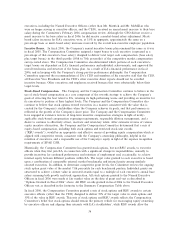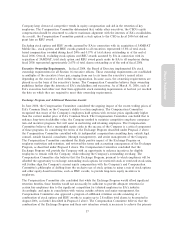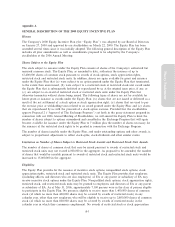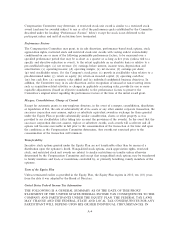Electronic Arts 2006 Annual Report Download - page 50
Download and view the complete annual report
Please find page 50 of the 2006 Electronic Arts annual report below. You can navigate through the pages in the report by either clicking on the pages listed below, or by using the keyword search tool below to find specific information within the annual report.objective of improving the Company's ability to retain and motivate employees, while still having a
favorable impact on overhang.
Fiscal 2006 CEO Compensation
Compensation for the CEO is determined through a process similar to that discussed above for other
executives in general. In Ñscal 2006, EA's Human Resources department gathered CEO compensation
data from several nationally recognized surveys and conducted a proxy analysis comparing Mr. Probst's
compensation to that of other CEOs. The analysis, which was reviewed by the Compensation Committee's
independent compensation consulting Ñrm, demonstrated that Mr. Probst's total cash compensation
(consisting of base salary plus bonus target) was below the 50th percentile of the market while his 2005
equity grant value was within the highest quartile of the market. In February 2006, this analysis was
provided to the Compensation Committee for consideration.
The Compensation Committee then conferred with the full Board (other than Mr. Probst) in a closed
session to further review and discuss the results of the market analysis, to review Mr. Probst's performance
evaluation, and to recommend compensation adjustments. The Compensation Committee recommended,
and the independent members of the Board approved, a market-based salary increase for Mr. Probst of
3.5%, establishing a new base salary of $734,850 per annum. As a result of EA's Ñnancial performance in
Ñscal 2006, Mr. Probst did not receive a cash performance incentive bonus for Ñscal 2006.
Also in February 2006, the Compensation Committee approved a new stock option grant to Mr. Probst for
225,000 shares of common stock based upon the retention and incentive factors discussed above and taking
into account market comparisons, prior option grant history, the level of vested versus unvested shares and
the number of shares Mr. Probst already owned at the time of the grant. The shares will Ñrst vest and
become exercisable as to 24% of the shares 12 months after the date of grant, and will then vest as to an
additional 2% of the shares on the Ñrst calendar day of each month thereafter for 38 months. This grant
reÖects the Compensation Committee's continuing policy to subject a substantial portion of Mr. Probst's
overall compensation each year to the market performance of the Company's common stock, to maintain
his option holdings at a level consistent with that for other chief executive oÇcers of the survey
companies, and to maximize the retention value of those option holdings.
Other
Company-provided air travel for EA's executives is for business purposes only. EA's use of non-
commercial aircraft is limited to appropriate business travel.
In June 2002, EA hired Warren Jenson as Chief Financial and Administrative OÇcer. As part of its
eÅorts to recruit Mr. Jenson, EA agreed to loan him $4 million, to be forgiven over four years based on
his continuing employment. The loan does not bear interest. The loan was made prior to enactment of the
Sarbanes-Oxley Act of 2002 and the prohibition on loans to executive oÇcers. However, the Compensation
Committee did review this proposed arrangement in light of the then-current environment and sensitivity
to transactions with management and determined the environment for recruiting highly regarded and
talented chief Ñnancial oÇcers was, and has been, intensely competitive, and the Compensation
Committee believed that a competitive compensation oÅer tied to continuing service was in EA's best
interests and signiÑcantly more beneÑcial to the Company than unrestricted cash payments. In June 2004,
pursuant to the terms of the loan agreement, EA forgave $2 million of the loan and provided Mr. Jenson
approximately $1.6 million to oÅset the tax implications of the forgiveness. The remaining outstanding loan
balance of $2 million was forgiven on June 24, 2006. No additional funds were provided to Mr. Jenson to
oÅset the tax implications of the forgiveness of the remaining $2 million.
Tax Law Limits on Executive Compensation
Section 162(m) of the Internal Revenue Code limits deductions for executive compensation in excess of
$1 million except for certain compensation which qualiÑes for a performance-based exception. Certain
types of compensation in excess of $1 million are deductible by the Company if performance criteria are
38
























